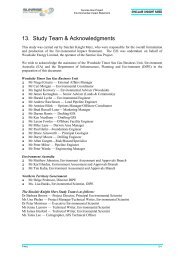Appendix D Terrestrial and Aquatic Biodiversity - Environment ...
Appendix D Terrestrial and Aquatic Biodiversity - Environment ...
Appendix D Terrestrial and Aquatic Biodiversity - Environment ...
Create successful ePaper yourself
Turn your PDF publications into a flip-book with our unique Google optimized e-Paper software.
D-3. Desktop Review<br />
3.1 Climate<br />
The project area experiences a tropical climate with a distinct a Wet <strong>and</strong> Dry season, which strongly<br />
influences temporal variability of faunal activity (<strong>and</strong> flora/habitat/resource presence) throughout the year.<br />
The Wet season typically occurs between November <strong>and</strong> April, <strong>and</strong> the Dry season between April <strong>and</strong><br />
November. The Wet season is associated with monsoon troughs <strong>and</strong> occurrence of tropical lows/cyclones<br />
which produce significant rainfall events, <strong>and</strong> often result in flood events. In contrast, the Dry season<br />
experiences negligible rain which results in river/creek flow reduction/cessation <strong>and</strong> billabongs/wetl<strong>and</strong>s<br />
drying up or at least reducing to small pools.<br />
The project area experiences an average rainfall between 600 – 800mm per year. The closest weather<br />
stations to the project area are Ngukurr (Station 14609) <strong>and</strong> Limmen River (Station 14645), which are<br />
approximately 60km to the north <strong>and</strong> south respectively.<br />
Mean maximum monthly rainfall ranges between 182 <strong>and</strong> 252mm (January) <strong>and</strong> a mean minimum monthly<br />
rainfall ranges between 0.1 <strong>and</strong> 0.7mm (August) for Ngukurr <strong>and</strong> Limmen River. The mean daily minimum<br />
temperatures at Ngukurr range from 15.1 to 25.5°C a nd a maximum mean daily temperature range from 29.6<br />
– 38.9 °C. Average annual evaporation is approxima tely 2,400mm for the region which, even in the wettest<br />
of years, exceeds the annual rainfall.<br />
All information was sourced from Bureau of Meteorology in December 2012. More detailed climate<br />
discussion with figures <strong>and</strong> tables is available in the Roper Bar Iron Ore EIS 2012.<br />
3.2 Bioregion<br />
The Interim Biogeographic Regionalisation for Australia (IBRA) divides Australia into units of broadly similar<br />
l<strong>and</strong>form, geology <strong>and</strong> biodiversity (Baker et al. 2005). The project falls within two bioregions (Figure 4):<br />
• Gulf Fall <strong>and</strong> Upl<strong>and</strong>; <strong>and</strong><br />
• Gulf Coastal bioregions.<br />
Gulf Falls <strong>and</strong> Upl<strong>and</strong>s Bioregion<br />
This bioregion includes Lawn Hill (in Queensl<strong>and</strong>), <strong>and</strong> parts of Elsey NP <strong>and</strong> the recently established<br />
Limmen NP in the Northern Territory. The Gulf Falls <strong>and</strong> Upl<strong>and</strong>s bioregion comprises undulating terrain<br />
with scattered low, steep rocky hills. The most extensive vegetation is woodl<strong>and</strong> dominated by Eucalyptus<br />
<strong>and</strong> Corymbia species with spinifex understorey, <strong>and</strong> woodl<strong>and</strong> dominated by Eucalyptus species with<br />
tussock grass understorey.<br />
The rocky s<strong>and</strong>stone ranges of this bioregion have some significant refugial values, <strong>and</strong> include some<br />
endemic or near-endemic species. Threatened species include the highly localised <strong>and</strong> endangered<br />
Carpentarian Grasswren (Amytornis dorotheae) <strong>and</strong> the endangered Gouldian Finch (Erythrura gouldiae),<br />
with additional restricted range species such as Gehyra borroloola <strong>and</strong> Cryptoblepherus zoticus which are<br />
dependent on rocky range habitat.<br />
Important rivers within this bioregion include the Roper <strong>and</strong> McArthur Rivers. Riparian areas are generally in<br />
reasonably good condition, but are suffering some degradation from uncontrolled livestock, other feral<br />
animals (buffalo, horses, pigs, <strong>and</strong> donkey). More localised conservation issues include weed infestations,<br />
pollution associated with mining, <strong>and</strong> altered fire regimes.<br />
This bioregion supports 10 species listed as threatened federally or in the State/Territory.<br />
(Source: NRETAS website)<br />
Client: Western Desert Resources Ltd Page 36 of 150<br />
Doc No. DW120004-C0302-EIA-R-0036<br />
Doc Title: <strong>Appendix</strong> D – <strong>Terrestrial</strong> <strong>Biodiversity</strong> Technical Report



